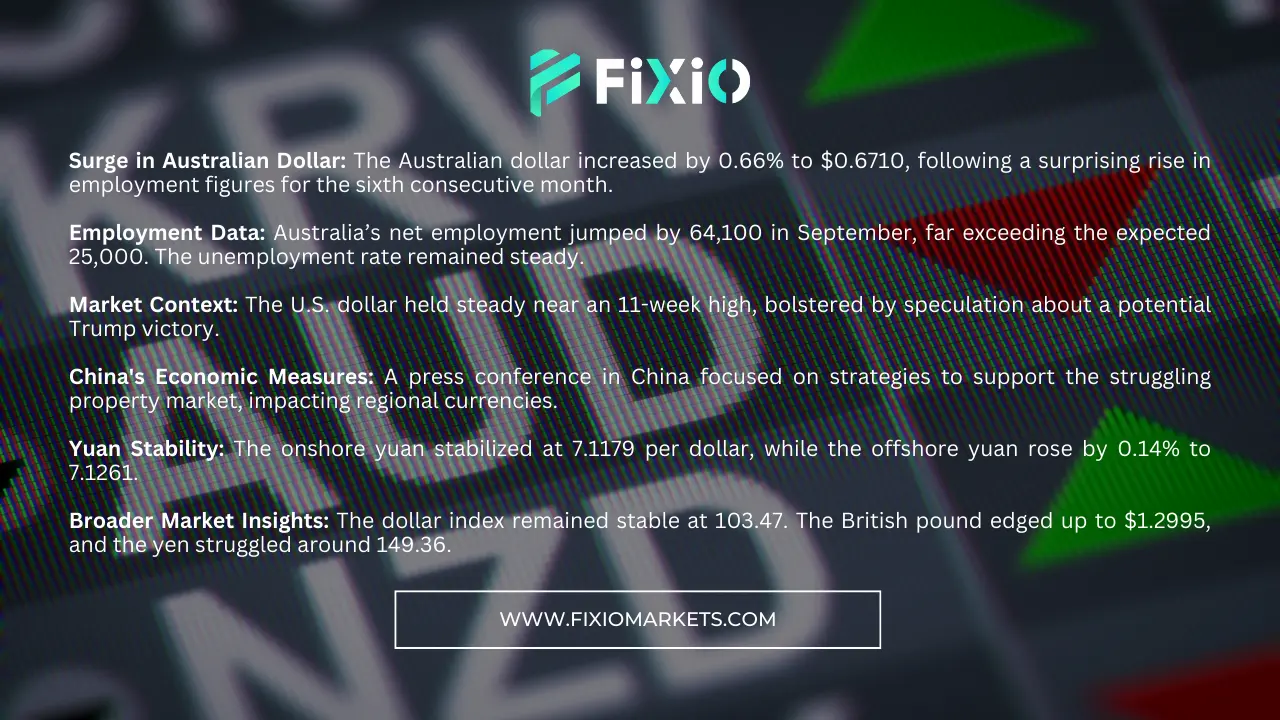
The Australian dollar surged on Thursday following a surprising rise in employment figures that surpassed expectations for the sixth consecutive month. Meanwhile, the Australian dollar strengthened as the U.S. dollar held steady near an 11-week high, buoyed by speculation surrounding a potential Trump victory in the upcoming U.S. election.
A significant event for Asia was a press conference in China, which started at 0200 GMT, centering on strategies to support the country’s struggling property market.
During this time, the onshore yuan remained stable at 7.1179 per dollar, while its offshore counterpart rose by 0.14% to 7.1261 per dollar. The Australian dollar, frequently viewed as a proxy for the Chinese yuan, increased by 0.66% to $0.6710, driven by the strong domestic jobs report.
The latest data revealed that net employment in Australia jumped by 64,100 in September, significantly exceeding the market expectation of a 25,000 increase. The unemployment rate held steady, leading traders to reassess the likelihood of an interest rate cut by the Reserve Bank of Australia (RBA) in December.
Abhijit Surya, an economist at Capital Economics, stated, "This employment data reinforces the RBA’s view that labor market conditions remain tight relative to full employment. Given the robust labor market, the RBA is unlikely to cut rates before the first half of next year."
In the wider market context, the dollar remained strong, having reached an 11-week high against a basket of currencies in the previous session. The British pound edged up to $1.2995 but was still near a two-month low due to disappointing inflation data. The yen struggled around the 150 per dollar mark, last noted at 149.36, while the euro was stable at $1.0864 ahead of a key monetary policy announcement from the European Central Bank.
The dollar's strength has been supported by a series of favorable U.S. economic indicators, as well as the potential for a Republican victory in the upcoming election. Thierry Wizman, a strategist at Macquarie, commented, "Trump’s core policies on tariffs, immigration, and taxes could lead to a more inflationary outlook in the U.S., decreasing the likelihood of aggressive Fed rate cuts."
The dollar index remained stable at 103.47 after peaking at 103.60 in the previous session. Additionally, the New Zealand dollar saw a slight increase of 0.28% to $0.6074, recovering from a two-month low, as domestic inflation returned to the Reserve Bank of New Zealand’s target range of 1% to 3%, leaving room for continued rate cuts.
To stay updated on market trends, visit our blog.

The Australian dollar climbs sharply after strong job figures, while the U.S. dollar remains stable, fueled by economic optimism and political possibilities.
Superior trade execution & trading conditions with the NDD method.

The online FX industry provides a platform for investors worldwide to engage in the buying and selling.

Subscribe to our daily newsletter and get the best forex trading information and markets status updates
Trade within minutes!
Comment (0)